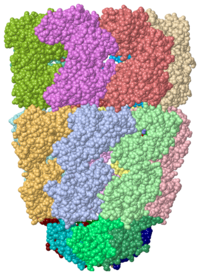
Crystal Structure of Chaperonin,
1pcqChaperonins (Cpn) are oligomeric proteins that mediate the folding of polypeptide chains. Group I CPN are found in bacteria, chloroplasts and mitochondria. For an introductory overview, see Chaperonins in Wikipedia.
The most characterized Cpn are in the GroEL/GroES complex from Escherichia coli and Cpn60/Cpn10 from Thermus thermophilus.[1] The larger subunit (GroEL, Cpn60) contains 3 domains: apical, intermediate and equatorial domain. The apical domain is the one which binds the polypeptide substrate. The equatorial domains binds the nucleotide.
- Group II Cpns are found during mitosis in eukaryotic cytosol and archaea.
- Thermosome is a Cpn complex found in archaea.[2]
- CCT or TRiC is a Cpn complex found in eukarya believed to be involved in uncontrolled proliferation.[3], [4]
- (GroEL in green, GroES in magenta, PDB entry 1pcq).
- .
- . GroEL in cyan.
- .
- .
- .
- .
- See also Chaperones.
- For GroEl in Hebrew see Sand box groel.
3D Structures of Chaperonin
Chaperonin 3D structures
Files for 3D printer
Asymmetric Chaperonin Complex GroEL/GroES by Marius Mihasan

